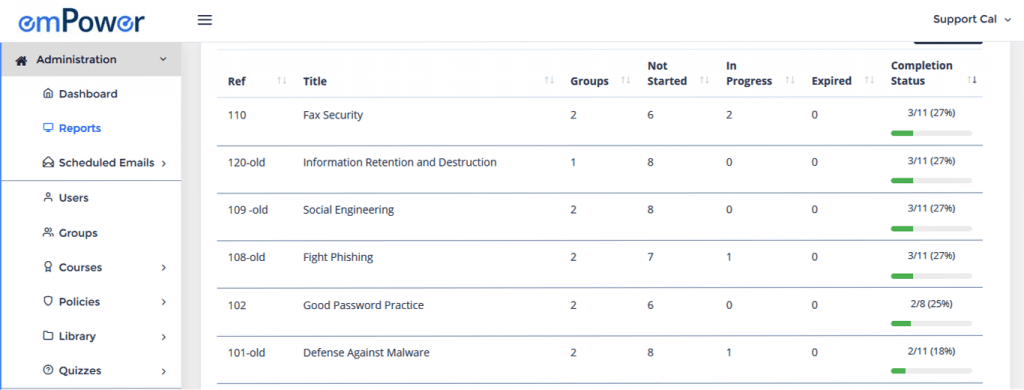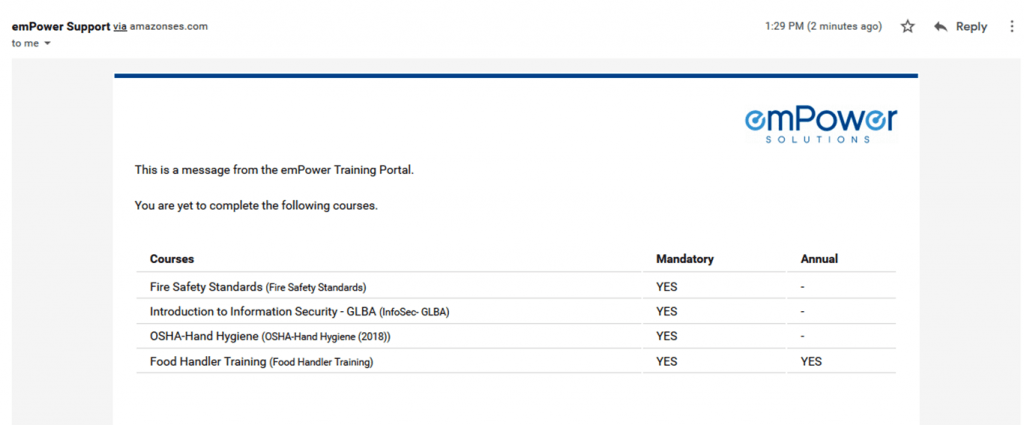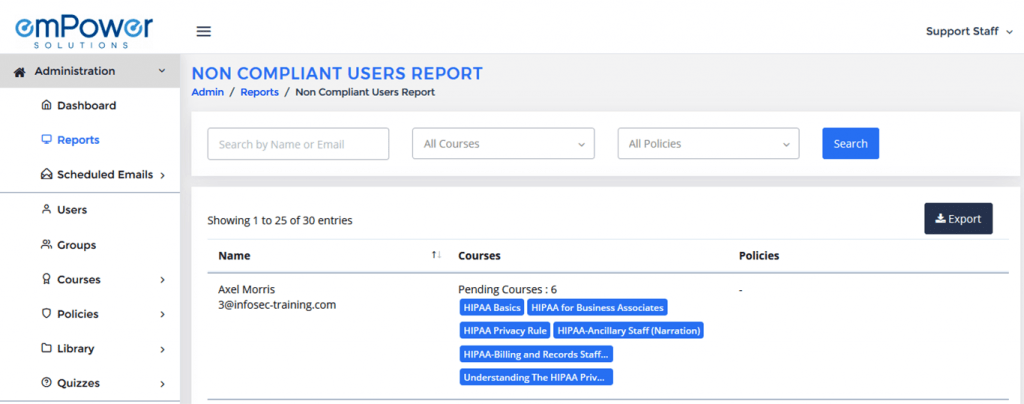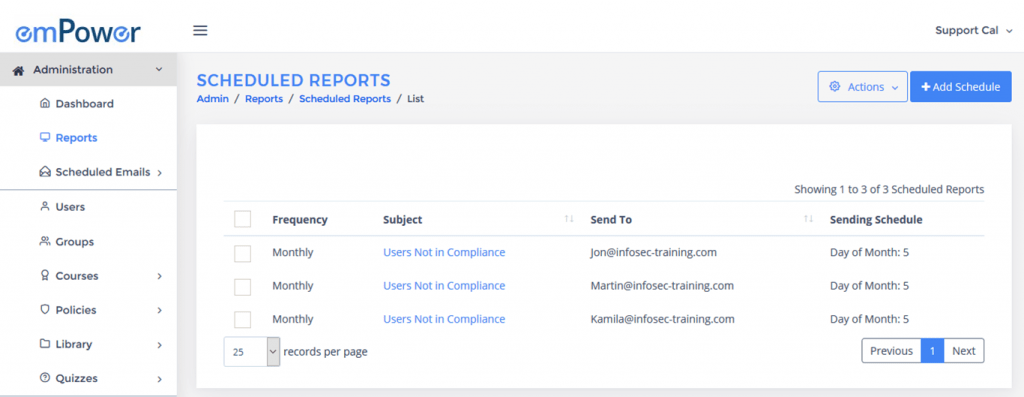Compliance training is about training employees on laws that apply to their work. You must train them to follow the applicable laws, regulations and policies. Failure to conduct such training can attract severe penalties from regulatory bodies. Both federal and state laws are strict on compliance training.
Yet so many organizations fail to train their employees. Why does it happen? Why is managing compliance training so difficult?
Most companies cite the following three reasons –
- Inadequate resources
- Small training staff and
- Huge distributed workforce
We want you to probe deeper. You can resolve all three problems cited above with eLearning and a good learning management system. But are the above three really the only reasons that affect your compliance training program?
Can you meet the audit deadline?
Let’s consider the following scenario. You manage compliance training for a large healthcare organization with offices in New York, Virginia and Texas. Suddenly, you receive a memo alerting you that an internal compliance audit would happen in three months. As per the memo, you must ensure training compliance within these three months.
Unfortunately, a pandemic has forced most of the New York workforce to work from home. On the other hand, travel restrictions won’t allow you to visit the Virginia offices.
How would you meet the audit deadline? Read on to learn how a compliance LMS could help you in a variety of ways to handle this tough situation.
How to manage your compliance training easily and effectively
Training completion overview report
First, you’d want to find out which compliance training programs are still pending. Next you’d want to know which offices, work groups, and work shifts are yet to finish their training. It could work even better, if you could find out the percentage of the workforce that’s yet to complete a training program. This information would help you with
- Prioritizing training programs, and
- Identifying supervisors you need to connect with.
Email non-compliant users
You can also connect with all employees directly, and ask them to finish the training program assigned to them. For this, you’d need to prepare the list of employees who have pending assignments, along with the list of what’s pending. Once you have the information, you can email everyone the list of training that they need to complete ASAP.
Non-compliant users report
This may appear to be a tiresome activity that would take hours to finish; even so, the timeline really depends on the learning management system that you use. Such a task could also be finished in minutes if your LMS support –
- Creating a report of non-compliant users
- Emailing selected employees
Moreover, the emailing feature should allow you to use tags that add the list of pending training courses into an email. If your LMS has such a feature, then all you’d need to do is to schedule the email, the LMS would ensure that your employees receive the intimation of the training programs that they need to complete.
But, what if employees come back to you complaining that they cannot complete their training assignments owing to their workload! Under such a scenario, you should contact their supervisors explaining the urgency of the situation with the list of employees who need to complete their training immediately.
Proactive approach to compliance training
Use Nagging emails
Although effective, the methods shared above are a reactive approach to compliance training. Your aim as a compliance officer should be ensuring training compliance from the beginning of the year.
Compliance officers should run non-compliance reports regularly for identifying employees who haven’t finished their training. Schedule regular nagging emails for such employees.
For instance, you have 20 office employees at your plant in Huston, Texas. These employees need to take OSHA compliance training for office employees.
Use your LMS, and schedule monthly nagging emails for your Huston-Office-OSHA group. Every month, the LMS would tally the list of Huston office employees against courses assigned to them. The LMS would then send a nagging email to employees who haven’t yet finished their training. Your email would also list the courses that the employees need to complete.
Email Supervisors regularly
You can also use this proactive approach with supervisors too. Use your LMS to schedule a monthly report of non-compliant employees. All supervisors should receive these reports at the beginning of each month.
The information would allow floor supervisors to schedule training into their shift plan for the month. This practice could help cut non-productive training hours resulting from unscheduled training. By following this process, you could also help boost the overall productivity of your organization.
Set due-date reminders
Another trick for tackling the issue of unscheduled training is to set up due-date training reminders for employees. Setup these reminders for as early at 90 days. Let the employee know that they have only 90 days left for finishing their training program. Send such reminders to them every 30 days.
Teams that manage multiple solutions may have to be trained to follow various regulations. Similarly, employees working on the same project but situated in different states would have to be trained to follow the state laws too. You can deal with the first case by assigning employees to multiple training groups. However, for the second case, you’d need to train the employees for state laws that he or she must follow.
Maintain training records
The two scenarios aren’t just complex in terms of assigning training, but they are complex in terms of recordkeeping too. Every regulation has different recordkeeping rules. Auditors might ask for a variety of reports –
- List of employees trained
- Proof of training
- List of training assignments for a work-site
- List of training assignments to an employee
- Total hours of training
Your learning management system should be capable of handling such complex training and reporting requirements.
Conduct training early in the year
You should always be proactive when it comes to compliance training. Ensure that all employees complete their training early in the year. You can achieve such a feat only with a compliance LMS. With an LMS designed for compliance purposes, you can free yourself from repetitive tasks, such as –
- Nagging employees every week.
- Reminding supervisors about non-compliant workers
- Sending compliance reports to your supervisors
- Filing weekly compliance and non-compliance reports.
Moreover, if an emergency training need arises – such as retraining in view of a safety incident – a compliance LMS would let you conduct retraining with least effort.
Besides, using a compliance LMS would help you save the time spent on adding new employees and scheduling them for training. It would also help you to refresh old content and add fresh training material.
Do you face any trouble with compliance training? How do you manage the training of your employees? Have you started using an LMS? How’s your experience of using an LMS for compliance training? Please share your experience with our readers.









